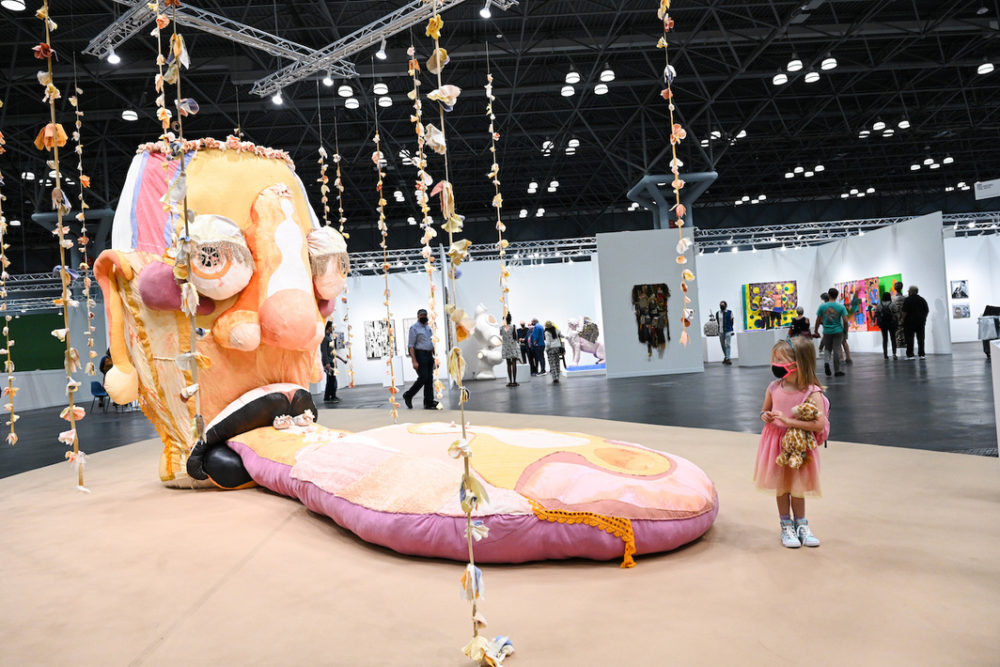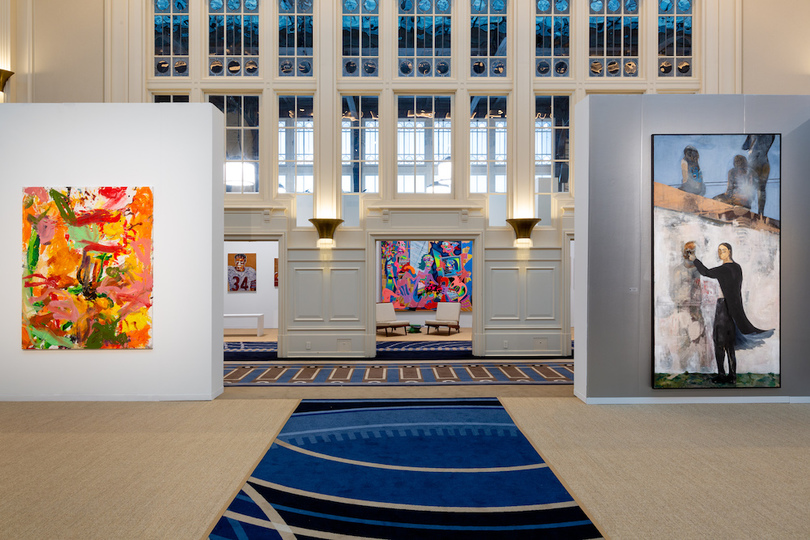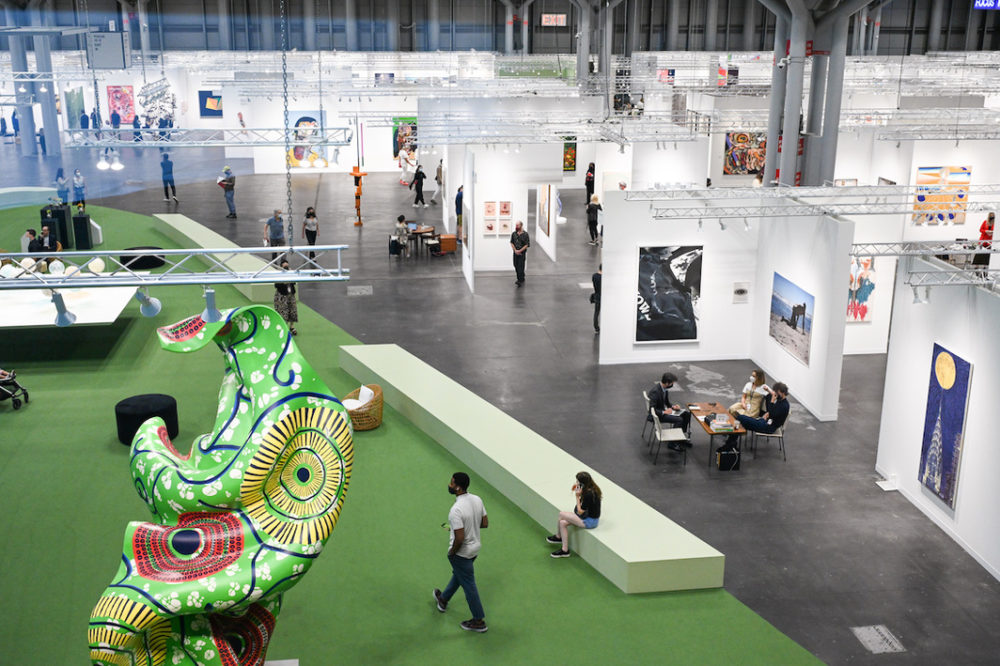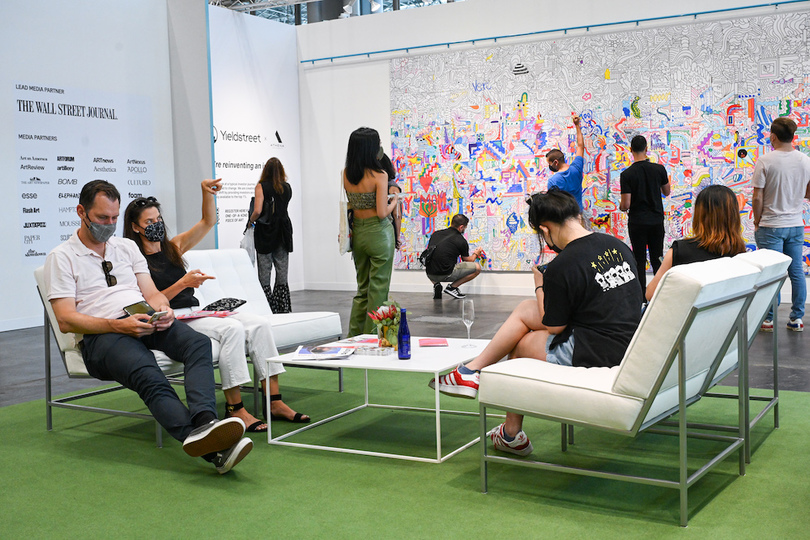
- Source: ARTFORUM
- Author: MAX LAKIN
- Date: SEPTEMBER 15, 2021
- Format: ONLINE
Moveable Feasts
Max Lakin at the Armory Art Fair and Independent

Tau Lewis’s Opus (The Ovule), 2021, presented by Los Angeles’s Night Gallery at the Armory Show’s Platform section. Photo: Casey Kelbaugh.
INDEPENDENT’S ABILITY TO CHOOSE locations that have private members clubs is unmatched. This year it had left Spring Studios, where someone told me it was outbid by Fashion Week, for the Battery Maritime Building, where a Cipriani recently moved in and bolted a gaudy nameplate to the facade, insisting it be called Casa Cipriani, which no one did. It’s an absurd place, but also a fitting expression of New Yorkers’ recent yen for dining in traffic and pretending they’re in the Veneto. People enjoyed six dollar Diet Cokes and plastic bowls of pasta on the terrace, which has spectacular views overlooking the Battery Park Underpass.
Inside, Axel Vervoordt had three panels caked in black earth by Bosco Sodi that absorbed all light and hope, a meditation on the plague year according to the wall text, but mostly what Sodi does anyway. The curator Max Wolf, late of Red Bull Arts, had assembled a presentation of the undersung Cleveland artist Ken Nevadomi’s berserk neo Expressionist paintings and drawings, easily the best thing I saw all week. “New world, new solutions,” he said. How was he finding the mood so far? “Enthusiastic?” he asked back.
Independent’s best feature is its size, which is small—this year it was forty-three galleries, most of which showed just one or two artists, which gives the whole thing a saner gloss contra the Armory’s warehouse liquidation freak-out. There were twenty fewer galleries than last March, which is the right direction, but I think it can be taken further: less galleries, less art. We’re very close to reverse-engineering the gallery, and I’m confident we can get there soon.
Between the ornate Beaux-Arts ballroom and the lush carpeting in wavy patterns, like if Hilma af Klint did textiles, the space had the feel of bar mitzvah receptions I’ve attended, except this one was lorded over by massive Julian Schnabel paintings (“courtesy of the artist and Cipriani”). Technically these were not part of the fair, but they flavored it. The person manning Nicelle Beauchene’s booth gamely explained that Schnabel’s wall label did not refer to Louise Despont’s meticulous, mesmeric line drawings directly under it, and you had to chalk it up to bad luck that he seemed destined to do so for the remainder of the week.

View of the twelfth Independent Art Fair, held in a Cipriani building downtown. Photo: Alexa Hoyer.
An art fair is no place for a baby. It’s loud and hot, not to mention vulgar. And yet there were plenty of overstimulated toddlers at the Armory Show on Saturday afternoon, harnessed to dads in wire-rimmed glasses or being traumatized by Tau Lewis’s enormous regurgitating quilted head, screaming their own heads off, which in the show’s new home at the Javits Center, reverberates with fantastic acoustical efficiency.
Who doesn’t feel like screaming lately? After so many lurching starts to New York’s grandly overstated recovery, here was a year and a half’s worth of the city’s art scene sausage-stuffed into a single week. And here we all were at the end of it, tired and disoriented, adrift on the far west side of Manhattan on the twentieth anniversary of 9/11. “This is my ex-stepdaughter,” said a woman in electric fuchsia pants at The Hole’s booth, introducing a not-much-younger-looking woman. Everyone is a little more dispossessed these days.
The Armory Show is now two sites removed from its namesake location, having abandoned the vertigo-inducing piers for the vertigo-inducing Javits Center, a non-place that no one likes, and that two months ago was a mass vaccination center, and last year was filled with rows of cots, conscripted as an emergency field hospital. But considering that the piers were basically falling into the river anyway, and the last installment is now acknowledged to have basically been a superspreader event, everyone agreed it was time for a change.

View of the Armory Show at the Javits Center. Photo: Casey Kelbaugh.
The swing from overflow hospital to art megamall is also vertigo-inducing, but no one seemed particularly bothered. Most people walked around in their surgical masks holding plastic champagne flutes, which gave the whole thing an air of cataclysmic opulence. Art fairs persist in spite of everyone’s better judgment, including my own. Amid everything else, the plague year offered a perfect reason to eradicate fair culture altogether. What use did we have for its acrid blend of airless desperation anymore? Weren’t most transactions done online now, as everyone helpfully kept reminding me? Yet we were here still, again, sweating in a booth-addled fugue state. No lessons were learned.
Most of the exhibiting dealers were saying how happy they were to be there. Maybe that was true, but each time I heard it I thought of that episode of the Twilight Zone where the adults were terrorized by a six-year-old who would zap you into the cornfield for negative thinking. Relentless positivity is self-preservation, especially at these prices.
At the Armory, a few galleries brought solo presentations, which were pleasant, but most fell back on the manic custom of seeing how much of their roster they could fit inside a twelve-foot cubicle, which always has the feeling of selling art out the back of a truck. “It’s so much nicer to have a solo booth,” agreed Erin Goldberger at Half Gallery’s, which was only showing Andrea Joyce Heimer’s pastel paintings of Montana life. “Our Frieze booth was psychotic. We had, like, everyone, and it was so hard memorizing where everyone went to fucking school.” Charles Moffett took the solo route too, staging an excellent New York–homecoming of Kenny Rivero’s recent exhibition at the Brattleboro Museum, transposed mostly wholesale: fantastical drawings and collages made on things retrieved from the trash of the luxury Gramercy Park building where he worked as a doorman, a neat parallel for this whole thing.

Fairgoers color in a mural presented by Mike Perry and Yieldstreet, a digital investing platform, at the Armory Show. Photo: Casey Kelbaugh.
In fact a lot of work captured the dominant mood: Doubts 2020?, one of Faig Ahmed’s distorted Persian carpets that melted off the wall and pooled onto the floor of Sapar Contemporary’s booth; some new Kennedy Yanko sculptures of torqued metal draped with sheaths of pliable paint that crumpled in elegant despondency, at Vielmetter’s; Jennifer Rose Sciarrino’s copulating carved marble slugs, at Daniel Faira’s. “That’s tastefully different, but it could be brighter,” said a woman wearing stacked clogs, dismissing a Tsuyoshi Maekawa linen work. It seemed harsh, but then again maybe the palette was a bit dour. There’s something attractive about defiance—of reality, common sense, the needs of newborns—and that seemed to be the fair’s main attitude.
Too many people were indulging a participatory Mike Perry mural, signing up (?) to wait (?) to color in a wall-size doodle that was actually an ad for an art investment start-up: the kind of undignified behavior (free labor for brands) people love partaking in lately, which should have been Perry’s point, but probably wasn’t.
Time does not behave normally within an art fair. 1:30 becomes 5:30 rather disconcertingly. The same Mel Bochner canvas laughs at you—HA HA HA HA—as you lap it for, what, the fifth time? The eighth? It’s like Last Year at Marienbad but with halogen lights. Wealthy-looking Spaniards FaceTimed with a baby from the VIP Lounge, where you could enjoy the same $12 slice of Junior’s cheesecake available to the proles, but in penned-off seclusion next to a vitrine of David Yurman jewelry. By 6 p.m. the late summer sun glinted off one of the Hudson Yards towers—who knows which—refracted through the Javits’ trussed crystal kaleidoscope. It was beautiful but you really had to squint.

